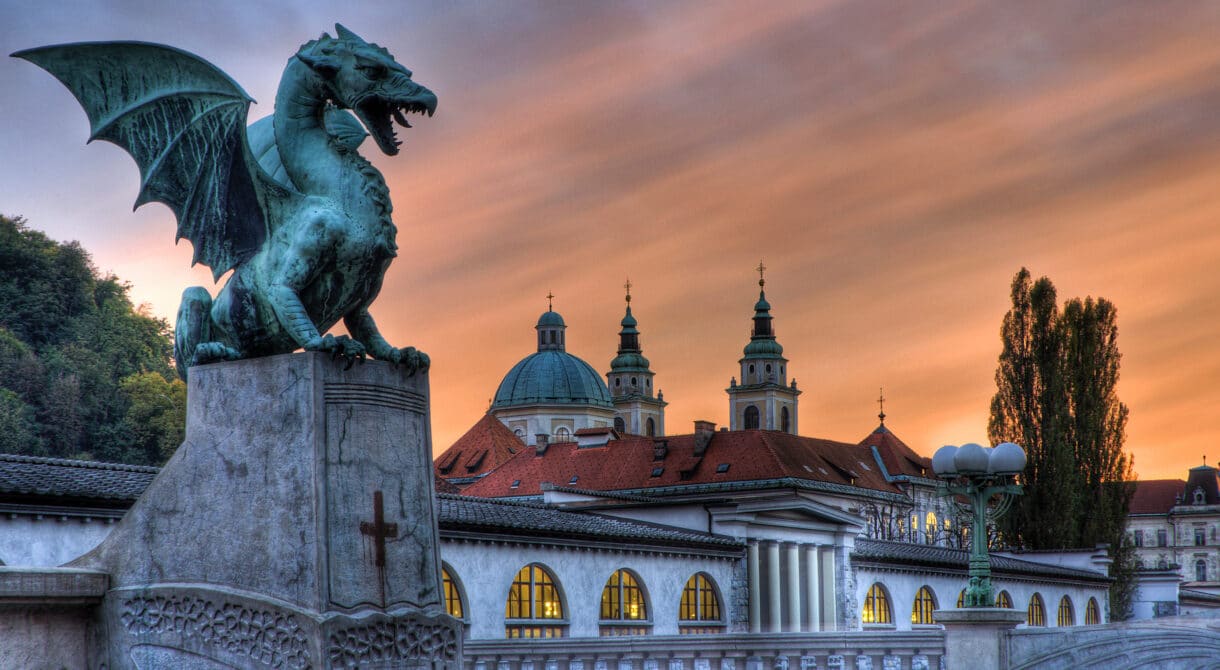Slovenia had always been on my list of destinations I was eager to visit. The people from there who I had happened to meet on trade shows were always friendly, with a certain warmth to them, and a genuine enthusiasm for the country they were in charge of promoting and selling. The trip I took mid-October certainly lived up to my expectations, especially in these strange times.
Human & Knowledgeable
With less than 300,000 residents, Ljubljana is compact, definitely walkable, and built to the human scale. Despite its relatively small size, it offers all the comfort of big capitals, and has preserved a small-town friendliness and uniqueness of its own, due to its location at the crossroads of Central European and the Mediterranean, halfway between Vienna and Venice. If its location within a two-hour flight from almost all major European airports makes it a conveniently accessible destination, it certainly has nothing to blush about compared to its counterparts that play in the same court. Its wealth of history, style, arts and culture makes the city very attractive for delegates and visitors alike.
Ljubljana’s extremely picturesque and green character shouldn’t hide the fact that the city is also a knowledge hub. The international reputation of its university is no secret: it boasts a total of 23 faculties, ranging from law and philosophy to medicine, theology and technology, and three art academies covering theatre, radio, film and television, as well as fine arts, design and music. In terms of key industries, the most important ones currently are still the car, transport and pharmaceutical industries, along with a fast growth of energy, ICT (with a unique UNESCO sponsored centre for Artificial Intelligence) and tourism and hospitality industry – areas which European and international associations can definitely tap into when they are hosted in the country.
When it comes to conferences, Ljubljana unsurprisingly boasts the largest number of meeting facilities in Slovenia. I was given a special private tour of one of the two main congress centres in the city: Cankarjev dom, the work of famous Slovenian architect Edvard Ravnikar, lies in the heart of Ljubljana, and is home to more than 2,500 events every year. With an overall capacity of 5,000, they are actually the only congress centre and organiser in Slovenia offering a comprehensive congress service, ranging from professional congress organisation to seamless technical implementations. I was personally impressed by the dynamic layout of the venue, together with a unique façade casing made of white marble.
The 2019 ICCA statistics have ranked Ljubljana as the world’s 44th and Europe’s 27th most popular international conference destination, and there’s no reason why these rankings won’t improve in the near future, given all the infrastructure investment that’s currently going on in the city. Just across the Intercontinental Hotel – the only 5-star in the city – we were lucky enough to stay at, there was a construction site of another hotel which will add up to the already 3,000 existing rooms in Ljubljana. In fact, there will be a 40% increase of hotel rooms by 2025, I was told.
The city is actually so compact that the two conference centres – the second one being the highly versatile Ljubljana Exhibition and Convention Centre – numerous conference hotels, and special venues can all be reached by foot. As the distances are so close, organizing a conference in Ljubljana is logistically simple, and delegates just don’t waste time commuting from one place to the other. Also, did I mention the airport also lies only 20 minutes away from the centre? And that most of the main attractions of the country are within a 90-minute drive?

Differentiating factor
More information
On Slovenia: nastja.ravselj@slovenia-convention.com / www.slovenia-convention.com
On Ljubljana: tatjana.radovic@visitljubljana.si / https://www.visitljubljana.com/en/meetings/
Which leads to another differentiating aspect of the Slovenian capital: its strength in the sustainability field. Ljubljana has indeed implemented a number of sustainable measures, including green mobility, waste management and sustainable urban planning. As the inner part of the city centre has been closed for traffic since 2012, the residents of Ljubljana are increasingly opting for cycling as a means of transport, while the free-of-charge Bicike(LJ) bicycle sharing system has also become very popular.
Some international accolades that the Slovenian capital has won in the last years include the prestigious title of European Green Capital 2016, the “Tourism for Tomorrow 2015” destinations award for sustainable development by the World Travel and Tourism Council. Ljubljana has also been listed six times in the Top 100 Sustainable Destinations in the World (2015-2020). Most recently, within the European Capital of Smart Tourism competition – a new initiative launched by the European Commission – the city won the 2019 award in the Sustainable Tourism category and the 2020 award in the Digitalisation category.
In the hospitality sector, Ljubljana has been part of the Green Scheme of Slovenian Tourism since 2015. It is a certification system offering tools for the assessment and improvement of sustainable development initiatives through the trademark SLOVENIA GREEN – this way, suppliers and providers can really say they walk the sustainable talk.
As an example, the Green Supply Chains is a very interesting project, where Ljubljana Tourism actively collaborates with the City of Ljubljana Department for Environmental Protection, the Association for Sustainable Tourism GoodPlace and the Cooperative for Rural Development Jarina. The goal here is to connect the producers of local food and the hotel and restaurant managers, encouraging them to use 100 % locally grown ingredients in their kitchens. A trend which is not a trend is in Ljubljana, but a true way of life.
